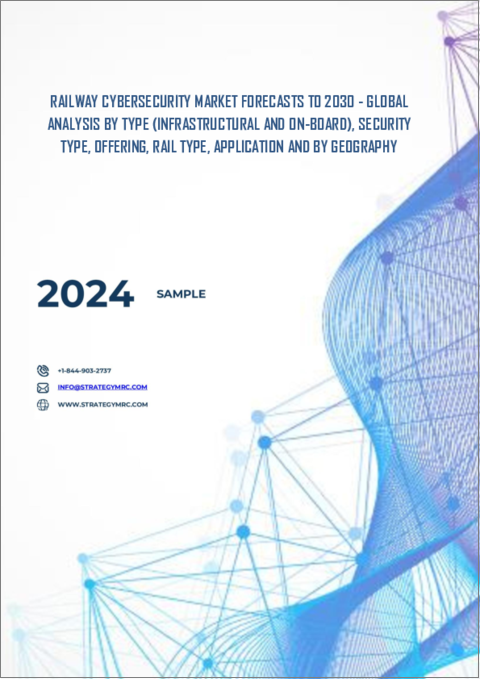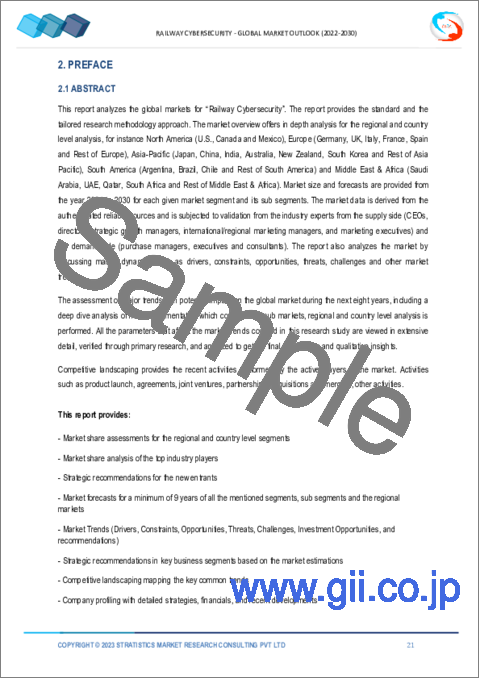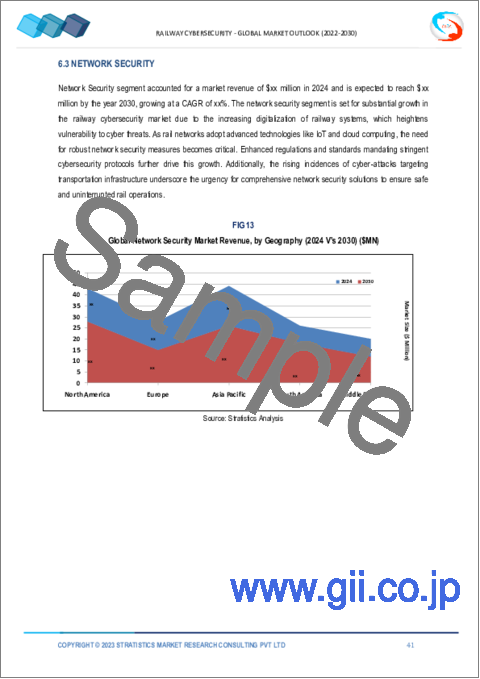|
|
市場調査レポート
商品コード
1358962
鉄道サイバーセキュリティ市場の2030年までの予測:タイプ別、セキュリティタイプ別、オファリング別、鉄道タイプ別、用途別、地域別の世界分析Railway Cybersecurity Market Forecasts to 2030 - Global Analysis By Type (Infrastructural and On-board), Security Type, Offering, Rail Type, Application and By Geography |
||||||
カスタマイズ可能
|
|||||||
| 鉄道サイバーセキュリティ市場の2030年までの予測:タイプ別、セキュリティタイプ別、オファリング別、鉄道タイプ別、用途別、地域別の世界分析 |
|
出版日: 2023年10月01日
発行: Stratistics Market Research Consulting
ページ情報: 英文 200+ Pages
納期: 2~3営業日
|
- 全表示
- 概要
- 図表
- 目次
Stratistics MRCによると、世界の鉄道サイバーセキュリティ市場は2023年に76億米ドルを占め、予測期間中のCAGRは11.4%で成長し、2030年には163億米ドルに達すると予測されています。
現代の鉄道システムの安全性、信頼性、完全性を保証するために、鉄道サイバーセキュリティは極めて重要な要素です。デジタル技術やモノのインターネット(IoT)が鉄道インフラに急速に統合されるにつれて、これらのシステムをサイバー脅威や脆弱性から守る必要性が高まっています。鉄道サイバーセキュリティは発展途上の分野であり、新たな危険や技術に対応するために継続的な注意と努力が必要です。鉄道事業者、テクノロジー・サプライヤー、政府機関、サイバーセキュリティの専門家はすべて、現代における鉄道システムのセキュリティと安全性を確保するために果たすべき役割を担っています。
デジタル化の進展
鉄道は重要なインフラと見なされているため、その途絶は国家安全保障に影響を及ぼす可能性があります。自国の利益を守るため、各国政府は列車のセキュリティに資金を費やしています。列車制御システム、信号システム、旅客情報システムといった技術の使用により、現代の鉄道システムはデジタル化が進んでいます。このデジタル化により、オンライン脅威の攻撃対象が拡大するため、サイバーセキュリティ・ソリューションの必要性が高まっています。一般市民や乗客は、安全で信頼できる鉄道サービスを期待しています。さらに、鉄道事業者は、サイバーセキュリティの侵害によって社会的信用が損なわれた後、自社のブランドを守るためにサイバーセキュリティへの投資を決定する可能性があり、これが市場の成長を後押ししています。
既存のシステムの脆弱性
システムの脆弱性とは、制御システム、情報システム、システム手順、制御、実装において、脅威源によって悪用される可能性のある欠陥のことです。ポリシーの手順、アーキテクチャの設計、コンフィギュレーションのメンテナンス、物理的な侵入、ソフトウェア開発、通信ネットワーク、トレーニングの認識不足など、多くの要因がこのような脆弱性につながる可能性があります。厳格なミッション・クリティカル要件と安全要件、大規模鉄道輸送システム全体にわたるネットワーク技術のマッピング、さまざまなサブシステム間の相互依存関係、膨大な量のリアルタイム・データへのアクセスなどは、鉄道輸送システム特有の脆弱性のほんの一例に過ぎないです。したがって、上記のすべての要因が市場の成長を妨げています。
インフラ拡張と国境を越えた業務の増加
国境を越えた国際的な業務は、多数の鉄道事業者によって行われています。国境を越えたソリューションや専門知識を提供する企業にとって、国境を越えたサイバーセキュリティの確保は特に困難であり、またチャンスでもあります。さらに、高速鉄道網や都市交通システムは、新たな鉄道インフラ・プロジェクトの一例であり、サイバーセキュリティの安全対策を当初から組み込むことで、より安全性を高めることができます。
サイバーセキュリティサービス導入の高コスト
鉄道のサイバーセキュリティ分野における主な障害の1つは、導入コストの高さです。ブラジル、南アフリカ、インドでは、インフラが不十分なため、複数のソリューションやサービスの導入が困難です。鉄道輸送プロジェクトのための土地購入は高額で、PPP(官民パートナーシップ)契約の対象となり、政府の許可が必要です。同様に、ネットワーク依存度の高い鉄道システムでさえも、ビジネスのあらゆる分野でIoTの導入が進んでいます。そのため、インフラ建設の遅れによって、最新のテクノロジーやソリューションの利用が制限されています。サイバーセキュリティ・ソリューションの導入には、多額の初期費用がかかるという障壁があります。エンドユーザー向け伝送ネットワークのセットアップ、現場レベルの機器のセットアップ、老朽化したインフラの交換、予知保全、人工知能、ビッグデータ、軽便鉄道車両のクラウドコンピューティングに最先端技術を活用すると、全体的なコストがさらに上昇し、市場の妨げになります。
COVID-19の影響:
パンデミック(世界的大流行)のため、サイバー犯罪者は、遠隔地での作業や状況の変化への対応を急ぐことによって生じるギャップを利用したサイバー攻撃を増加させました。こうした攻撃は鉄道システムにも及びました。この流行により、他のセクターと同様、多くの鉄道職員が遠隔地勤務を余儀なくされました。この移行の結果、重要なシステムへのリモート・アクセスが必要になったため、攻撃対象が増加し、鉄道はサイバー攻撃の影響を受けやすくなり、鉄道のサイバーセキュリティ業務を通じてデータを保護する必要性が高まっています。
予測期間中、インフラ部門が最大となる見込み
インフラ部門には、鉄道フラグ、乗客データフレームワーク、プラットフォーム管理フレームワーク、発券フレームワーク、その他多数のフレームワークなど、相互接続された膨大な量のインフラが含まれるため、インフラ部門は有利な成長を遂げると推定されます。これらの機能は、初期の鉄道フレームワークの大半のプラットフォームに含まれているため、インフラ部門におけるサイバーセキュリティの必要性が高まっています。
予測期間中、ネットワーク・セキュリティ分野のCAGRが最も高くなると予想される
ネットワーク・セキュリティ分野は、予測期間中に最も高いCAGRの成長が見込まれています。鉄道ネットワーク、列車、その他の鉄道施設間のリアルタイム・データと高速通信リンクを採用することで、鉄道ネットワーク・セキュリティはすべてのトラフィックを制御・自動化し、集中型の鉄道ネットワーク管理を可能にするからです。このシステムは、運行管理、保守サポート、交通計画など、多くのタスクを実行します。さらに、ネットワーク・セキュリティ・システムは、サイバー攻撃や大災害の管理にも対応するため、ネットワークセキュリティ市場を強化しています。
最大のシェアを占める地域
北米は、サイバー攻撃が増加し複雑化するにつれて、地域のサイバー鉄道セキュリティも上昇し、予測期間中に最大の市場シェアを占めると予測されています。さらに、重要なセクターに対する著名なサイバー攻撃の余波を受け、コンプライアンスを強制するため、運輸保安局(TSA)は、報告要件とともに、鉄道および航空事業に新たなサイバーセキュリティ規則を課す予定です。したがって、最先端の鉄道および政府規制技術の導入が、この分野の市場拡大を後押しすると思われます。
CAGRが最も高い地域:
アジア太平洋地域は、予測期間中CAGRが最も高くなると予測されます。これは、鉄道網の拡張に起因しており、その結果、アジア太平洋地域における幹線鉄道および都市鉄道インフラの建設は、同地域の急速な都市化と人口増加によって大きく後押しされています。同地域の主な影響要因としては、GDPの着実な成長、より洗練された技術の普及、新興経済などが挙げられます。
無料カスタマイズサービス:
本レポートをご購読のお客様には、以下の無料カスタマイズオプションのいずれかをご利用いただけます:
- 企業プロファイル
- 追加市場プレーヤーの包括的プロファイリング(3社まで)
- 主要企業のSWOT分析(3社まで)
- 地域セグメンテーション
- 顧客の関心に応じた主要国の市場推計・予測・CAGR(注:フィージビリティチェックによる)
- 競合ベンチマーキング
- 製品ポートフォリオ、地理的プレゼンス、戦略的提携に基づく主要企業のベンチマーキング
目次
第1章 エグゼクティブサマリー
第2章 序文
- 概要
- ステークホルダー
- 調査範囲
- 調査手法
- データマイニング
- データ分析
- データ検証
- 調査アプローチ
- 調査ソース
- 1次調査ソース
- 2次調査ソース
- 前提条件
第3章 市場動向分析
- 促進要因
- 抑制要因
- 機会
- 脅威
- 用途分析
- 新興市場
- 新型コロナウイルス感染症(COVID-19)の影響
第4章 ポーターのファイブフォース分析
- 供給企業の交渉力
- 買い手の交渉力
- 代替品の脅威
- 新規参入業者の脅威
- 競争企業間の敵対関係
第5章 世界の鉄道サイバーセキュリティ市場:タイプ別
- インフラストラクチャ
- オンボード
第6章 世界の鉄道サイバーセキュリティ市場:セキュリティタイプ別
- アプリケーションのセキュリティ
- ネットワークセキュリティー
- データ保護
- エンドポイントセキュリティ
- システム管理
第7章 世界の鉄道サイバーセキュリティ市場:オファリング別
- ソリューション
- ウイルス対策/マルウェア対策
- 暗号化
- ファイアウォール、
- 侵入検知システム/侵入防御システム
- リスクとコンプライアンスの管理
- その他のソリューション
- サービス
- 設計と実装
- リスクと脅威の評価
- サポートとメンテナンス
- その他のサービス
第8章 世界の鉄道サイバーセキュリティ市場:鉄道タイプ別
- 在来旅客列車
- 都市交通
- 高速鉄道
第9章 世界の鉄道サイバーセキュリティ市場:用途別
- 旅客列車
- 貨物列車
- 地下鉄列車
第10章 世界の鉄道サイバーセキュリティ市場:地域別
- 北米
- 米国
- カナダ
- メキシコ
- 欧州
- ドイツ
- 英国
- イタリア
- フランス
- スペイン
- その他欧州
- アジア太平洋地域
- 日本
- 中国
- インド
- オーストラリア
- ニュージーランド
- 韓国
- その他アジア太平洋地域
- 南米
- アルゼンチン
- ブラジル
- チリ
- その他南米
- 中東とアフリカ
- サウジアラビア
- アラブ首長国連邦
- カタール
- 南アフリカ
- その他中東とアフリカ
第11章 主な発展
- 契約、パートナーシップ、コラボレーション、合弁事業
- 買収と合併
- 新製品の発売
- 事業拡大
- その他の主要戦略
第12章 企業プロファイル
- Thales Group
- Siemens AG
- Nokia Networks
- Wabtec
- Alstom
- Cisco Systems, Inc.
- Hitachi Ltd.
- Huawei Technologies Co., Ltd.
- International Business Machine Corporation(IBM)
- Bombardier
- Raytheon Technologies Corporation
- General Electric
- United Technologies
- ABB
- BAE Systems
- Cervello
- Toshiba Corporation.
List of Tables
- Table 1 Global Railway Cybersecurity Market Outlook, By Region (2021-2030) ($MN)
- Table 2 Global Railway Cybersecurity Market Outlook, By Type (2021-2030) ($MN)
- Table 3 Global Railway Cybersecurity Market Outlook, By Infrastructural (2021-2030) ($MN)
- Table 4 Global Railway Cybersecurity Market Outlook, By On-board (2021-2030) ($MN)
- Table 5 Global Railway Cybersecurity Market Outlook, By Security Type (2021-2030) ($MN)
- Table 6 Global Railway Cybersecurity Market Outlook, By Application Security (2021-2030) ($MN)
- Table 7 Global Railway Cybersecurity Market Outlook, By Network Security (2021-2030) ($MN)
- Table 8 Global Railway Cybersecurity Market Outlook, By Data Protection (2021-2030) ($MN)
- Table 9 Global Railway Cybersecurity Market Outlook, By End Point Security (2021-2030) ($MN)
- Table 10 Global Railway Cybersecurity Market Outlook, By System Administration (2021-2030) ($MN)
- Table 11 Global Railway Cybersecurity Market Outlook, By Offering (2021-2030) ($MN)
- Table 12 Global Railway Cybersecurity Market Outlook, By Solutions (2021-2030) ($MN)
- Table 13 Global Railway Cybersecurity Market Outlook, By Antivirus/Antimalware (2021-2030) ($MN)
- Table 14 Global Railway Cybersecurity Market Outlook, By Encryption (2021-2030) ($MN)
- Table 15 Global Railway Cybersecurity Market Outlook, By Firewall, (2021-2030) ($MN)
- Table 16 Global Railway Cybersecurity Market Outlook, By Intrusion Detection System/Intrusion Prevention System (2021-2030) ($MN)
- Table 17 Global Railway Cybersecurity Market Outlook, By Risk And Compliance Management (2021-2030) ($MN)
- Table 18 Global Railway Cybersecurity Market Outlook, By Other Solutions (2021-2030) ($MN)
- Table 19 Global Railway Cybersecurity Market Outlook, By Services (2021-2030) ($MN)
- Table 20 Global Railway Cybersecurity Market Outlook, By Design And Implementation (2021-2030) ($MN)
- Table 21 Global Railway Cybersecurity Market Outlook, By Risk And Threat Assessment (2021-2030) ($MN)
- Table 22 Global Railway Cybersecurity Market Outlook, By Support And Maintenance (2021-2030) ($MN)
- Table 23 Global Railway Cybersecurity Market Outlook, By Other Services (2021-2030) ($MN)
- Table 24 Global Railway Cybersecurity Market Outlook, By Rail Type (2021-2030) ($MN)
- Table 25 Global Railway Cybersecurity Market Outlook, By Conventional Passenger Trains (2021-2030) ($MN)
- Table 26 Global Railway Cybersecurity Market Outlook, By Urban Transit (2021-2030) ($MN)
- Table 27 Global Railway Cybersecurity Market Outlook, By High-Speed Rail (2021-2030) ($MN)
- Table 28 Global Railway Cybersecurity Market Outlook, By Application (2021-2030) ($MN)
- Table 29 Global Railway Cybersecurity Market Outlook, By Passenger Trains (2021-2030) ($MN)
- Table 30 Global Railway Cybersecurity Market Outlook, By Freight Trains (2021-2030) ($MN)
- Table 31 Global Railway Cybersecurity Market Outlook, By Metro Trains (2021-2030) ($MN)
Note: Tables for North America, Europe, APAC, South America, and Middle East & Africa Regions are also represented in the same manner as above.
According to Stratistics MRC, the Global Railway Cybersecurity Market is accounted for $7.6 billion in 2023 and is expected to reach $16.3 billion by 2030 growing at a CAGR of 11.4% during the forecast period. In order to guarantee the security, dependability, and integrity of contemporary rail systems, railway cybersecurity is a crucial component. A greater need to defend these systems from cyberthreats and vulnerabilities has arisen as digital technologies and the Internet of Things (IoT) are being integrated into railway infrastructure at a faster rate. Railway cybersecurity is a developing field that needs continual care and effort to keep up with emerging dangers and technologies. Railway operators, technology suppliers, governmental organizations, and cybersecurity professionals all have a part to play in ensuring the security and safety of railroad systems in the modern era.
According to the Organization for Economic Co-operation and Development (OECD), passenger transport by rail for million passenger-kilometers has witnessed steady growth over the past decade.
Market Dynamics:
Driver:
Increasing digitalization
Since railroads are regarded as important infrastructure, their disruption may have an impact on national security. To protect their interests, governments are spending money on train security. With the use of technology like train control systems, signaling systems, and passenger information systems, modern railway systems are becoming more digital. Because of this digitization, cybersecurity solutions are more necessary as the attack surface for online threats grows. The general public and passengers expect safe and dependable railroad services. Moreover, railway operators may decide to invest in cybersecurity in order to protect their brand after a cybersecurity compromise damages public trust thus propelling the growth of the market.
Restraint:
Existing system vulnerabilities
System vulnerabilities are flaws that can be exploited by a threat source in control systems, information systems, system procedures, controls, or implementations. Many factors, including policy procedure, architecture design, configuration maintenance, physical infiltration, software development, communication networking, and lack of training awareness, can lead to such vulnerabilities. The strict mission-critical and safety requirements, the mapping of networked technology across large-scale rail transportation systems, the interdependencies among various subsystems, and access to enormous amounts of real-time data are just a few examples of vulnerabilities unique to rail transportation systems. Hence all the above factors hamper the growth of the market.
Opportunity:
Growing infrastructure expansion and cross-border operations
Cross-border and international operations are conducted by a large number of railroad operators. For businesses providing cross-border solutions and expertise, ensuring cybersecurity across borders provides particular difficulties and opportunities. Moreover, high-speed rail networks and urban transit systems are examples of new railway infrastructure projects that present opportunity to build-in cybersecurity safeguards from the beginning, making them more secure.
Threat:
High cost of cyber security services installation
One of the key obstacles in the rail cyber security sector is the high deployment cost. Deploying multiple solutions and services is difficult in Brazil, South Africa, and India due to insufficient infrastructure. Land purchase for railway transportation projects is expensive, subject to PPP (public-private partnership) agreements, and requires government permission. In a similar vein, every sector of business is implementing IoT, even the highly network-dependent rail systems. Delays in infrastructure construction thereby restrict the use of contemporary technologies and solutions; creating a barrier to deploying a cyber-security solution has a hefty upfront cost. Utilizing cutting-edge technologies for end-user transmission network setup, field-level equipment setup, aging infrastructure replacement, predictive maintenance, artificial intelligence, big data, cloud computing for light rail cars further increases the over all cost which impedes the market.
COVID-19 Impact:
Because of the pandemic, cybercriminals increased their cyberattacks, preying on gaps created by remote work and the haste to adjust to shifting circumstances. These attacks did not spare railway systems. The epidemic prompted many railway employees to work remotely, as it did in other sectors. As remote access to crucial systems became necessary as a result of this transition, the attack surface rose and trains became more susceptible to cyber assaults which has increased the need to protect the data through the railway cybersecurity operations
The infrastructural segment is expected to be the largest during the forecast period
The infrastructural segment is estimated to have a lucrative growth, as these infrastructure section includes a vast amount of interconnected infrastructure, including railway flagging, passenger data frameworks, platform management frameworks, ticketing frameworks, and numerous other frameworks. These functionalities are included on the majority of platforms for earlier railroad frameworks, which increases the need for cyber security in the infrastructure sector.
The network security segment is expected to have the highest CAGR during the forecast period
The network security segment is anticipated to witness the highest CAGR growth during the forecast period, because by employing real-time data and fast communication linkages between rail networks, trains, and other rail facilities, railway network security controls and automates all traffic and enables centralized rail network management. This system performs a number of tasks, including operation management, maintenance support, and traffic planning. Additionally, the network security system handles cyber-attacks and catastrophe management thereby enhancing the market for network security.
Region with largest share:
North America is projected to hold the largest market share during the forecast period as cyberattacks multiply and become more complicated, regional cyber railway security also rises. Additionally, in an effort to force compliance in the aftermath of high-profile cyberattacks on important sectors, the Transportation Security Administration (TSA) will impose new cyber security rules on the train and airline businesses, along with reporting requirements. Therefore, implementing cutting-edge railway and governmental regulation technologies will aid in the expansion of the market in this area.
Region with highest CAGR:
Asia Pacific is projected to have the highest CAGR over the forecast period, owing to the extension of rail networks and, as a result, the construction of mainline and urban rail infrastructure in the Asia Pacific are being driven in large part by the region's rapid urbanization and population increase. Significant players in the Asia Pacific region include Hitachi Ltd., Huawei, Toshiba, and Tech Mahindra Ltd. The main influencing factors for the region include expanding country GDPs steady growth, more sophisticated technology penetration, and developing economies.
Key players in the market:
Some of the key players profiled in the Railway Cybersecurity Market include: Thales Group, Siemens AG, Nokia Networks, Wabtec, Alstom, Cisco Systems, Inc., Hitachi Ltd., Huawei Technologies Co., Ltd., International Business Machine Corporation (IBM), Bombardier, Raytheon Technologies Corporation, General Electric, United Technologies, ABB, BAE Systems, Cervello and Toshiba Corporation.
Key Developments:
In September 2023, Thales and Intel Collaborate to enhance trust in confidential computing, this collaboration enables customers in highly regulated industries to secure workloads and protect data in use on-premises and in the cloud.
In September 2023, Nokia launches AVA Data Suite to run on Google Cloud to facilitate AI/ML development. Designed to run on Google Cloud, to help communication service providers (CSPs) standardize data and facilitate the development of AI/ML software applications.
In July 2023, Wabtec Partners with Vale on Alternative Fuels Study and Orders Three FLXdrive Battery-Electric Locomotives. The deal includes an order for three of Wabtec's FLXdrive battery locomotives and a collaboration to test ammonia as a potential clean, alternative fuel to replace diesel.
Types Covered:
- Infrastructural
- On-board
Security Types Covered:
- Application Security
- Network Security
- Data Protection
- End Point Security
- System Administration
Offerings Covered:
- Solutions
- Services
Rail Types Covered:
- Conventional Passenger Trains
- Urban Transit
- High-Speed Rail
Applications Covered:
- Conventional
- Passenger Trains
- Freight Trains
- Metro Trains
Regions Covered:
- North America
- US
- Canada
- Mexico
- Europe
- Germany
- UK
- Italy
- France
- Spain
- Rest of Europe
- Asia Pacific
- Japan
- China
- India
- Australia
- New Zealand
- South Korea
- Rest of Asia Pacific
- South America
- Argentina
- Brazil
- Chile
- Rest of South America
- Middle East & Africa
- Saudi Arabia
- UAE
- Qatar
- South Africa
- Rest of Middle East & Africa
What our report offers:
- Market share assessments for the regional and country-level segments
- Strategic recommendations for the new entrants
- Covers Market data for the years 2021, 2022, 2023, 2026, and 2030
- Market Trends (Drivers, Constraints, Opportunities, Threats, Challenges, Investment Opportunities, and recommendations)
- Strategic recommendations in key business segments based on the market estimations
- Competitive landscaping mapping the key common trends
- Company profiling with detailed strategies, financials, and recent developments
- Supply chain trends mapping the latest technological advancements
Free Customization Offerings:
All the customers of this report will be entitled to receive one of the following free customization options:
- Company Profiling
- Comprehensive profiling of additional market players (up to 3)
- SWOT Analysis of key players (up to 3)
- Regional Segmentation
- Market estimations, Forecasts and CAGR of any prominent country as per the client's interest (Note: Depends on feasibility check)
- Competitive Benchmarking
- Benchmarking of key players based on product portfolio, geographical presence, and strategic alliances
Table of Contents
1 Executive Summary
2 Preface
- 2.1 Abstract
- 2.2 Stake Holders
- 2.3 Research Scope
- 2.4 Research Methodology
- 2.4.1 Data Mining
- 2.4.2 Data Analysis
- 2.4.3 Data Validation
- 2.4.4 Research Approach
- 2.5 Research Sources
- 2.5.1 Primary Research Sources
- 2.5.2 Secondary Research Sources
- 2.5.3 Assumptions
3 Market Trend Analysis
- 3.1 Introduction
- 3.2 Drivers
- 3.3 Restraints
- 3.4 Opportunities
- 3.5 Threats
- 3.6 Application Analysis
- 3.7 Emerging Markets
- 3.8 Impact of Covid-19
4 Porters Five Force Analysis
- 4.1 Bargaining power of suppliers
- 4.2 Bargaining power of buyers
- 4.3 Threat of substitutes
- 4.4 Threat of new entrants
- 4.5 Competitive rivalry
5 Global Railway Cybersecurity Market, By Type
- 5.1 Introduction
- 5.2 Infrastructural
- 5.3 On-board
6 Global Railway Cybersecurity Market, By Security Type
- 6.1 Introduction
- 6.2 Application Security
- 6.3 Network Security
- 6.4 Data Protection
- 6.5 End Point Security
- 6.6 System Administration
7 Global Railway Cybersecurity Market, By Offering
- 7.1 Introduction
- 7.2 Solutions
- 7.2.1 Antivirus/Antimalware
- 7.2.2 Encryption
- 7.2.3 Firewall,
- 7.2.4 Intrusion Detection System/Intrusion Prevention System
- 7.2.5 Risk And Compliance Management
- 7.2.6 Other Solutions
- 7.3 Services
- 7.3.1 Design And Implementation
- 7.3.2 Risk And Threat Assessment
- 7.3.3 Support And Maintenance
- 7.3.4 Other Services
8 Global Railway Cybersecurity Market, By Rail Type
- 8.1 Introduction
- 8.2 Conventional Passenger Trains
- 8.3 Urban Transit
- 8.4 High-Speed Rail
9 Global Railway Cybersecurity Market, By Application
- 9.1 Introduction
- 9.2 Passenger Trains
- 9.3 Freight Trains
- 9.4 Metro Trains
10 Global Railway Cybersecurity Market, By Geography
- 10.1 Introduction
- 10.2 North America
- 10.2.1 US
- 10.2.2 Canada
- 10.2.3 Mexico
- 10.3 Europe
- 10.3.1 Germany
- 10.3.2 UK
- 10.3.3 Italy
- 10.3.4 France
- 10.3.5 Spain
- 10.3.6 Rest of Europe
- 10.4 Asia Pacific
- 10.4.1 Japan
- 10.4.2 China
- 10.4.3 India
- 10.4.4 Australia
- 10.4.5 New Zealand
- 10.4.6 South Korea
- 10.4.7 Rest of Asia Pacific
- 10.5 South America
- 10.5.1 Argentina
- 10.5.2 Brazil
- 10.5.3 Chile
- 10.5.4 Rest of South America
- 10.6 Middle East & Africa
- 10.6.1 Saudi Arabia
- 10.6.2 UAE
- 10.6.3 Qatar
- 10.6.4 South Africa
- 10.6.5 Rest of Middle East & Africa
11 Key Developments
- 11.1 Agreements, Partnerships, Collaborations and Joint Ventures
- 11.2 Acquisitions & Mergers
- 11.3 New Product Launch
- 11.4 Expansions
- 11.5 Other Key Strategies
12 Company Profiling
- 12.1 Thales Group
- 12.2 Siemens AG
- 12.3 Nokia Networks
- 12.4 Wabtec
- 12.5 Alstom
- 12.6 Cisco Systems, Inc.
- 12.7 Hitachi Ltd.
- 12.8 Huawei Technologies Co., Ltd.
- 12.9 International Business Machine Corporation (IBM)
- 12.10 Bombardier
- 12.11 Raytheon Technologies Corporation
- 12.12 General Electric
- 12.13 United Technologies
- 12.14 ABB
- 12.15 BAE Systems
- 12.16 Cervello
- 12.17 Toshiba Corporation.






